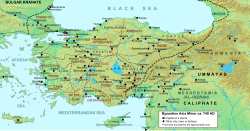Anatolic Theme
| Theme of the Anatolics Άνατολικόν θέμα, θέμα Άνατολικῶν |
|||||
| Theme of the Byzantine Empire | |||||
|
|||||
| The Byzantine themes of Asia Minor in circa 740 | |||||
| Historical era | Middle Ages | ||||
| • | Established | before 669 | |||
| • | Fall to the Seljuks. | ca. 1078 | |||
| Today part of |
|
||||
The Anatolic Theme (Greek: Άνατολικόν [θέμα], Anatolikon [thema]), more properly known as the Theme of the Anatolics (Greek: θέμα Άνατολικῶν, thema Anatolikōn) was a Byzantine theme (a military-civilian province) in central Asia Minor (modern Turkey). From its establishment, it was the largest and senior-most of the themes, and its military governors (stratēgoi) were powerful individuals, several of them rising to the imperial throne or launching failed rebellions to capture it. The theme and its army played an important role in the Arab–Byzantine wars of the 7th–10th centuries, after which it enjoyed a period of relative peace that lasted until its conquest by the Seljuk Turks in the late 1070s.
In its "classical" form during the 8th and 9th centuries, the theme stretched over the ancient regions of Lycaonia, Pisidia, Isauria, as well as most of Phrygia and parts of Galatia Salutaris. Initially, the Anatolic Theme included the western and southern shores of Asia Minor as well, but by ca. 720 they were split off to form the Thracesian and Cibyrrhaeot themes. Under Theophilos (r. 829–842), its eastern and south-eastern portions, facing the Arab frontier zone and including the forts that guarded the northern entrance to the Cilician Gates, were detached to form two new frontier districts (kleisourai), those of Cappadocia (originally a division, or tourma, of the Anatolics) and Seleucia. Emperor Leo VI the Wise (r. 886–912) later ceded the region west of Lake Tuz (the banda of Eudokias, Hagios Agapetos and Aphrazeia) to Cappadocia. The theme's capital was Amorium, until the sack of the city by the Abbasids in 838. After that, it was probably transferred to the nearby fortress of Polybotos.
...
Wikipedia

